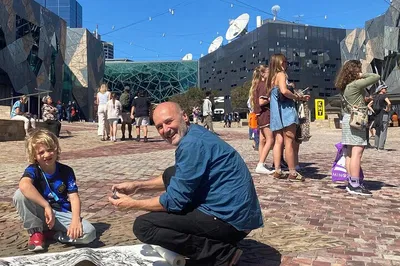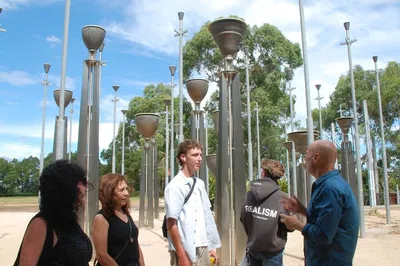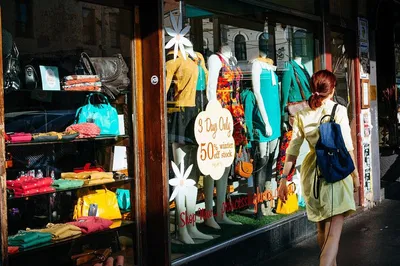Melbourne City Image Tour: Art, Culture & Hidden Gems
150
Overview
City Image Tour Melbourne explores the city's art and architecture. This walking tour, led by visual artist Anthony McInneny, shows how Melbourne became Australia's Cultural Capital. It's perfect for people who like art, history, and seeing a city in a new way.
The tour starts at Federation Square, a famous meeting place. Anthony will take everyone through cobblestone alleys, modern laneways, and across heritage bridges. The tour goes along the Yarra River, through plazas, and to a new park that connects arts and sports areas. Key stops include ACMI (Australian Centre for the Moving Image), Hosier Lane (known for its street art), and Flinders Street Station. People will also see the New Melbourne City Square, Nicholas Building & Cathedral Arcade, Degraves Street & Centre Place, Yarra River Northbank & Evan Walker Bridge, Sandridge Bridge, Southbank Promenade, Hamer Hall & Arts Precinct, Birrarung Marr, and William Barak Bridge & Federation Bells.
The tour includes the materials to make a memento at Federation Square. It does not include food, drinks, or personal shopping. With Anthony's knowledge, guests will discover hidden spots and understand how Melbourne has changed over time. This small-group tour offers a personal experience, with a focus on the city's unique public spaces.



Highlights
Discover Hidden Laneways: Explore Melbourne's secret alleys and find unique street art.
See Iconic Landmarks: Visit famous spots like Federation Square and Flinders Street Station.
Learn from an Expert: Hear stories from a local artist and urban expert.
Small Group Experience: Enjoy a personal tour with a small group of people.
Make a Memento: Create a souvenir at Federation Square to remember the tour.
Explore Art & Architecture: See how art and buildings have shaped Melbourne's culture.
Sentiment Analysis
Overall, customers really enjoyed the City Image Tour of Melbourne. They thought it was a great way to see the city's art, learn about its history, and discover hidden spots with a knowledgeable guide.

Customers loved seeing hidden gems and learning about Melbourne's history.
Many enjoyed the small group size, which made the tour feel personal.
Guests appreciated Anthony's knowledge and passion for the city's art and architecture.
Some visitors found the tour inspiring and gave them a new way to look at Melbourne.
A few people wished there was more time at certain stops.
One person thought the tour was too focused on history.
The Journey
ACMI (Australian Centre for the Moving Image)
Step into the Australian Centre for the Moving Image (ACMI), a postmodern architectural marvel designed by Lab Architecture Studio and Bates Smart, and recently renewed by BKK Architects and Razorfish. More than a museum, ACMI anticipates the ubiquitous nature of digital screen culture, showcasing a dynamic collection that traces the evolution of film and television from 1946 to the digital age. Directly connected to Federation Square, ACMI serves as a portal to Melbourne’s iconic public spaces, the National Gallery of Victoria, and the scenic Yarra River. Dive into the world of cinema, gaming, and digital art in this cultural hub.
Hosier Lane
Wander through the cobblestone alley of Hosier Lane, a vibrant canvas of Melbourne’s renowned street art culture, laid out in the original 1837 city grid by Robert Hoddle. Transforming into an outdoor gallery in 1996 thanks to City Lights studio, Hosier Lane attracts local, national, and international artists, turning its walls into a constantly evolving display of murals, stencils, and installations. Experience the raw energy and artistic freedom of this ever-changing urban landscape, drawing as many visitors annually as the city's major art museums.
New Melbourne City Square
Discover the New Melbourne City Square, a site steeped in history and modern design. Once the location of Melbourne’s original City Square (1980), this revitalized space now stands between Flinders Lane and the Town Hall, redesigned in 2025 by RSHP, Hassell, and Weston Williamson + Partners. The original City Square was halved in the 1990s. The New City Square integrates the entrance to Town Hall Station and features a digital interpretation of the Mockridge Fountain, evoking the essence of the 1996 New City Square. The Ron Roberston Swan sculpture The Vault (1980-1981), which was originally located here, can now be found at the Australian Centre for Contemporary Art.
Nicholas Building & Cathedral Arcade
Explore the Nicholas Building, a 1926 architectural gem designed by Harry Norris for the Nicholas Brothers, creators of Aspro. Today, it's a haven for 200 artists and creatives, fostering a thriving community. Wander through the L-shaped Cathedral Arcade, connecting Swanston Street to Flinders Lane and the City Library. Discover the cultural heart of this former rag trade district, experiencing its unique blend of history, art, and warehouse charm. A visit offers a peek into Melbourne's vibrant artistic soul.
Degraves Street & Centre Place
Immerse yourself in the vibrant atmosphere of the Degraves Street & Centre Place intersection on Flinders Lane, a bustling hub of cafés, boutiques, and street culture. Admire the Majorca Building (1930), boasting an exotic Spanish/Moorish Art Nouveau style designed by Harry Norris, with colorful faience façades. Descend into Campbell Arcade, an underground Creative Space initiative (est. 2025) connecting Flinders Street Station and Town Hall stations. Experience the eclectic energy of Melbourne’s laneway culture, where culinary delights meet architectural beauty.
Flinders Street Station
Marvel at Flinders Street Station, built in 1854 and designed by Fawcett and Ashworth Architects in the French Renaissance style. Observe the iconic Clock Tower at the intersection with Elizabeth Street. Explore the restored underground tunnel leading to the Yarra River's north bank. Discover the heritage significance of this site as the starting point of Australia's first city rail line, connecting Port Melbourne to the city center in 1854. Step into history at this central landmark.
Yarra River Northbank & Evan Walker Bridge
Connect with the Yarra River and cross the Evan Walker pedestrian Bridge (1992), named after the visionary minister who championed the Southgate project to reorient Melbourne to its river. Stroll along the three-kilometer Northbank promenade, part of the Green Line environmental restoration project. Visit the converted railway signal box (1854), now a youth digital art center projecting digital video art. Enjoy the fusion of history, nature, and contemporary art along this revitalized waterfront.
Sandridge Bridge
Cross the Sandridge Bridge, a steel railway bridge built in 1886 and repurposed in 2006 as a pedestrian connection. Originally built to transport people and goods from Port Melbourne, the bridge now features 'The Travellers' (2005), a kinetic sculpture by Nadim Karam, telling the story of the traditional owners and the immigrants who shaped Melbourne. Experience a blend of history, art, and cultural heritage on this iconic bridge.
Southbank Promenade
Stroll along the Southbank Promenade (1992), designed by Denton Corker and March, and immerse yourself in a vibrant display of public art and lively spaces. Discover the Red Stair Amphitheatre, Faultline (1996) by Hossein Valamanesh, Ponyfish Island (1992) bar-restaurant, Orphelia (1992) by Deborah Halpren, and Dervishes (1981) by Clement Meadmore. Experience the artistic energy and playful atmosphere of this riverside promenade.
Hamer Hall & Arts Precinct
Discover the heart of Melbourne’s arts scene at Hamer Hall (1982), designed by Roy Grounds, alongside the National Gallery of Victoria (NGV) and the State Theatre. Admire Inge King's Forward Surge (1976), a striking steel sculpture commissioned by the William Angliss Art Fund, standing between Hamer Hall and the State Theatre. This landmark precinct is a tribute to Melbourne's dedication to visual and performing arts.
Federation Square
Experience Federation Square, Melbourne's contemporary cultural hub, designed by Lab Architecture Studio and Bates Smart (2002). Admire the view of St Paul’s Cathedral (1891) framed by the square's modern architecture. Explore Nearamnew (2002), a public artwork by Paul Carter, integrated into the postmodern plaza. A visit to Fed Square is a deep dive into Melbourne's cultural dynamism.
Birrarung Marr
Explore Birrarung Marr, Melbourne's newest public park, designed by Ronald Jones, Helena Piha, Taylor Cullity Lethlean, and Paul Thompson, opened in 2002. Visit ArtPlay, a children’s art centre in the former railway yards. Discover Birrarung Wilam (Common Ground) (2006), featuring works by indigenous artists Vicki Couzens, Lee Darroch, and Treahna Hamm. Admire the gigantic Angel (1988) by Halpern. Immerse yourself in nature, art, and indigenous culture in this expansive parkland.
William Barak Bridge & Federation Bells
Cross the William Barak Bridge, named after the last traditional elder of the Wurundjeri-willam clan, and connect the cultural and sporting precincts of Melbourne. Experience Federation Bells, an installation and musical instrument comprising 39 upturned bells, designed by Anton Hasell and Neil McLachlan. Listen to the daily musical performances and enjoy the views overlooking the MCG. Conclude your tour at this intersection of culture and sports.
Know Before You Go
This tour includes the materials to make a memento at Federation Square. It does not include food, drinks, or personal shopping expenses. There is no specified pickup or drop-off location; the tour meets at a designated spot in Federation Square.
Hot Tip
Wear comfortable shoes, as this is a walking tour. Bring a water bottle to stay hydrated. Keep an open mind to truly appreciate Melbourne's art and architecture.





